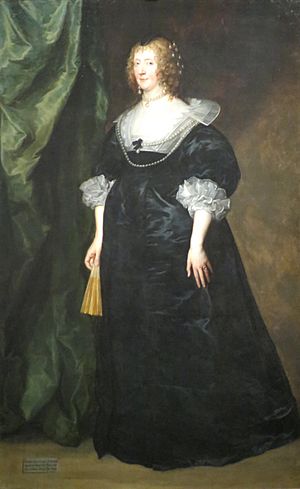Christian Cavendish, Countess of Devonshire facts for kids
Quick facts for kids
The Countess of Devonshire
|
|
|---|---|

Christian Bruce, by Anthony van Dyck
|
|
| Born | December 1595 |
| Died | 16 January 1675 (aged 79) |
| Spouse(s) |
William Cavendish, 2nd Earl of Devonshire
(m. 1608; died 1628) |
| Children |
|
| Parent(s) |
|
Christian Cavendish, Countess of Devonshire (born Bruce, 1595–1675) was an important and powerful woman from Scotland and England. She owned a lot of land and strongly supported the King during a difficult time in history. She was known for her intelligence and strength.
Contents
A Powerful Woman in History
Early Life and Marriage
Christian Bruce was born in 1595. Her father was Edward Bruce, 1st Lord Kinloss, a very important person in Scotland. Her mother was Magdalen Clerk. Christian was likely named because she was born around Christmas Day.
When she was a young girl, Christian was a companion to Princess Elizabeth. Princess Elizabeth was the daughter of King James I of England and Scotland. They spent time together at Coombe Abbey starting in 1604.
In 1608, when Christian was only about 12 or 13 years old, she married William Cavendish, 2nd Earl of Devonshire. As a wedding gift, she received a large sum of money. This was because her father had done great things for King James I. People described her as a "pretty red-haired wench."
Becoming Countess of Devonshire
In 1618, her husband became the Earl of Devonshire. From then on, Christian signed her letters as "C Devonshire." She and her husband had four children:
- Anne Cavendish (born around 1611)
- William Cavendish, 3rd Earl of Devonshire (born 1617)
- Charles Cavendish (born 1620)
- Henry Cavendish (died 1620)
Christian often welcomed important Scottish nobles to her home, Chatsworth House. These guests included people like the Earl of Morton and Sir Robert Kerr.
Managing the Family Estate
In 1628, Christian's husband, William Cavendish, passed away. Their son, also named William, was only 11 years old. This meant Christian had to take charge of her young son and the family's large land holdings. She was very good at managing the estates. She even made them more valuable through smart decisions.
Christian also had to deal with her husband's debts and many lawsuits. She handled these challenges with great skill. She moved to London with her family in 1634. She kept in touch with other important people, sharing news about the royal family.
Supporting the King
When the English Civil War began, Christian was a strong supporter of the King. She was a dedicated royalist. Sadly, her second son, Charles, was killed in battle in 1643.
After this, she moved to Ampthill in 1647. She lived with her brother, Thomas Bruce, 1st Earl of Elgin. During this time, she secretly wrote letters in a special code to other royalists. This helped them stay connected and share information. In 1650, she bought a house in Roehampton.
Christian continued to support the King even when he was not in power. She hosted many royalists at her home. She also communicated with royalists living in other countries. She even knew about General Monck's plan to bring the King back to power before it happened. Interestingly, she also had connections with Oliver Cromwell, who was in charge during this time.
After the King was restored to the throne, Charles II often visited Christian at her home in Roehampton. The King's mother, Henrietta Maria of France, was also very close with Christian.
Christian Cavendish passed away on January 16, 1675, at the age of 79. She was buried in Derby.
Her Letters and Friends
Christian Cavendish was known for her intelligence and wit. She was friends with many famous writers and thinkers of her time. One of her close friends was Edmund Waller, a poet. He even wrote poems dedicated to her. Another famous writer, John Donne, also praised her in his works.
Many of Christian's letters still exist today. In these letters, she shared news and gave advice. For example, she wrote to the Earl of Haddington about the Bishops' Wars. She advised him to be careful and not take sides too quickly. She believed it was better to be suspected by both sides than to be fully involved in the conflict.
Christian's biographer, Thomas Pomfret, wrote about her secret letters. These letters were written in a special code. She shared the work of decoding these messages only with her nephew and her chaplain. This shows how important and trusted she was among the royalists.


